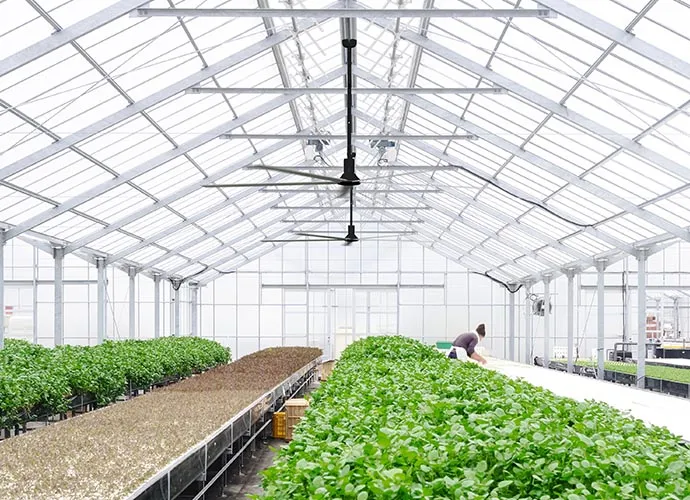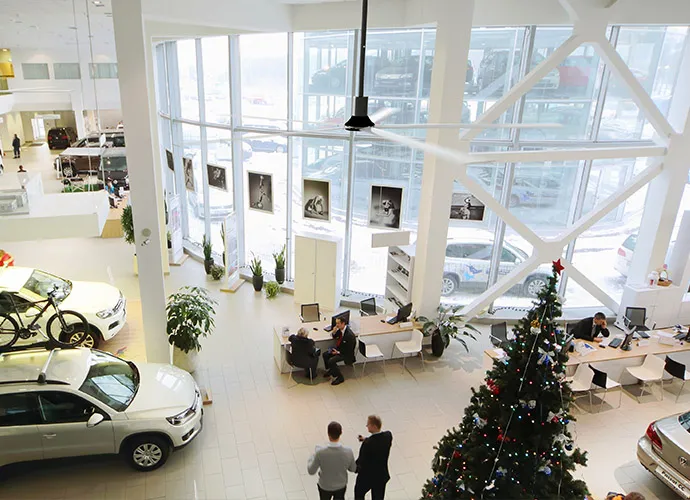Is your warehouse, gym, or factory still suffering from uneven air temperatures, poor comfort, and rising energy bills?
This is a challenge faced by every facility with grands espaces industriels ou espaces ouverts. Hot and cold spots, stuffy air, and high operating costs not only hurt productivity, but also make staff and customers uncomfortable. Many traditional overhead fans and air conditioners simply can’t move enough air at low speeds to solve the problem.
Here’s the good news:
UN ventilateur à haut volume et à basse vitesse—known as an Ventilateur HVLS—can transform your space. These big, slow-turning fans are designed to circulate a grand volume d'air throughout your facility. They create a gentle, effective breeze, deliver a significant effet rafraîchissant in summer, destratify air chaud in winter, and do it all with minimal energy.
UN ceiling fan that is designed for large areas is far different from residential ceiling fans. HVLS stands for volume élevé, faible vitesse: these fans produce enormous airflow (up to 500,000 CFM or more) at a very low speed (usually less than 100 RPM). Their massive blades—sometimes up to 24 pieds in diameter—gently push air down and across the floor.
How do HVLS fans work?
Where are HVLS fans used?

M650 Series HVLS Fans in agriculture barn
| Scénario | Key Problem | HVLS Fan Solution | Related Link |
|---|---|---|---|
| Large logistics warehouse | Hot spots, “dead air”, energy loss | M750 Series HVLS Fan | LOGISTICS HVLS FANS |
| Manufacturing plant | Fume build-up, uneven comfort | M650, Galvanized Hanging | FABRICATION |
| Gym or sports center | Stuffy air, poor cooling | Galvanized, M650 Series | CENTRES SPORTIFS |
| Greenhouse/barn | Moisture, animal stress | Galvanized Ceiling Fan | AGRICULTURE |
| Commercial/retail/airport | High AC bills, comfort complaints | Galvanized, Hunter Indust. | COMMERCIAL |
| Loft/home/open-plan living | Hard to heat/cool, drafts | Residential HVLS, Hunter | Ceiling Fans vs. HVLS Fans |
Expert Tip:
Pour grands espaces industriels with high ceilings or many racks, a single HVLS fan is often more effective than an array of small, high-speed fans. This is because HVLS fans produce high volume of air at low speeds, allowing air to circulate everywhere—even into “dead zones” or hard-to-reach corners.
HVLS fans deliver a high volume of air at low speeds, making them the most efficient choice for facilities needing broad, gentle airflow. When engineers use computational fluid dynamics to model air movement, they consistently find that les fans produisent more stable, healthier environments with less energy use.
| Type de ventilateur | Max Diameter (ft) | Max Airflow (CFM) | Fan W (Power) | Couverture typique |
|---|---|---|---|---|
| M750 Series HVLS Fan | 24 | 520,000 | 1,500W | 20,000–30,000 sq.ft. |
| M650 Series HVLS Fan | 18 | 350,000 | 980W | 10,000–20,000 sq.ft. |
| Ventilateur de plafond suspendu galvanisé | 12 | 140,000 | 650W | 5,000–10,000 sq.ft. |
| Ventilateur de plafond traditionnel | 3 | 7,000 | 180W | 200–500 sq.ft. |
A North American car parts plant replaced dozens of noisy, high-speed fans with three M650 Series HVLS fans. After installation:
Testimonial:
“Switching to HVLS industrial ceiling fans changed our operations—less noise, better air, and our energy bills have never been lower.”
— Operations Manager, FABRICATION
Unlike traditional ceiling fans that push fast air to a small area, Les ventilateurs HVLS fonctionnent by generating a slow-moving, powerful column of air at a very low speed. This airflow then spreads horizontally, keeping air temperatures and humidity consistent.
Caractéristiques principales :
Always check the expected volume of air at low speeds and make sure your selected fan is designed to circulate air for your unique application—manufacturing, warehouse, agriculture, or even ventilateurs de plafond résidentiels in modern homes.
How do HVLS fans provide better comfort and air quality than traditional overhead fans?
Unlike basic overhead fans that only stir air locally, HVLS fans are designed to circulate large amounts of air at low speeds throughout entire open spaces. The gentle, wide-reaching airflow helps améliorer l'air quality by moving dust, reducing moisture, and balancing air temperatures. That means fewer “dead zones” and a healthier indoor environment for both people and products.
Are HVLS fans worth it for residential ceiling or open-plan home use?
Absolutely. While most HVLS fans are built for commercial and industrial applications, there are ventilateurs de plafond résidentiels and “hunter industrial” style models sized for homes. Homeowners with large rooms or high ceilings love how a single HVLS fan delivers a large volume of air at low speed, replacing multiple small units, lowering energy use, and providing quiet, steady comfort.
What’s special about the Patterson V-Series HVLS fan?
Le Patterson V-Series stands out for its aerodynamic blade design and smart, energy-efficient controls. It can move a fan greater volume of air than many competitors and is often recommended for large industrial spaces where temperature consistency and energy savings are crucial.
What is fan w, and why does it matter?
“Fan w” refers to the wattage used by a fan. HVLS models are engineered to déplacer plus d'air per watt than traditional ceiling fans. For instance, an M750 Series can circulate over 500,000 CFM while consuming less than 1,500 watts, resulting in significant cost savings over time.
Can a single HVLS fan replace many small fans?
Yes—a single HVLS fan can often do the work of 6–10 standard ceiling fans, producing de grandes quantités d'air at a low speed. That means lower maintenance, less noise, and more cost-effective performance.
What makes HVLS fans differ from ordinary ceiling fans?
HVLS fans differ in their blade size, energy use, and the amounts of air they provide. Each HVLS ceiling fan that is designed for large spaces can move more air at low speed, delivering both energy savings and consistent air temperatures.
Why is the “amounts of air” a key factor for large buildings?
The amounts of air a fan can move is critical for destratification and comfort. Fans that deliver higher airflow help stabilize air temperatures and improve air quality in commercial and industrial spaces.
Are residential ceiling fans and industrial fans the same?
No. A residential ceiling fan that is designed for homes delivers comfort in smaller open spaces, while industrial fans provide larger amounts of air for warehouses and factories.
How do HVLS fans provide a cooling effect?
When HVLS fans deliver a constant breeze, the air moves across the skin, providing a gentle cooling effect even when air temperatures are high.
Increased Air Circulation for Warehouses
A global retailer’s distribution center installed four M750 Series HVLS fans to fix hot spots and moisture build-up. After the switch:
Evaporative Cooling in Sports Centers
A fitness facility upgraded to Galvanized Hanging Ceiling Fans and noticed an immediate difference:
Open Spaces in Agriculture
A greenhouse replaced overhead fans with a single HVLS unit, which les fans fournissent broad air movement across open spaces. Crops and workers both benefit from stable temperatures, lower disease risk, and fresher air.
Engineers use computational fluid dynamics to optimize blade shape and placement, ensuring that HVLS fans produce a high volume of air at low speeds. The result is gentle, even airflow that keeps air at a low velocity, avoiding drafts but maximizing comfort.
| Model / Series | Diameter (Feet) | Max Airflow (CFM) | Best Use Cases | Standout Feature | Internal Link |
|---|---|---|---|---|---|
| M750 Series HVLS Fan | 8–24 | 520,000 | Warehouses, logistics, factories | Highest volume, smart control | Ventilateurs HVLS série M750 |
| M650 Series HVLS Fan | 8–20 | 350,000 | Manufacturing, sports centers | Quiet, efficient | Ventilateurs HVLS série M650 |
| Ventilateur de plafond suspendu galvanisé | 7–14 | 140,000 | Commercial, agriculture, schools | Flexible mounting | Ventilateur de plafond suspendu galvanisé |
| Patterson V-Series HVLS Fan | 8–24 | 500,000+ | Grands espaces industriels | Aerodynamic, robust | Tout ce que vous devez savoir sur les ventilateurs à haut volume et à faible vitesse |
| Hunter Industrial / Residential Fan | 6–10 | 80,000–120,000 | Lofts, retail, open-plan homes | Stylish, quiet | Ceiling Fans vs. HVLS Fans |

Smart control HVLS fan in commercial building
Contrôles intelligents :
IoT, remote scheduling, and BMS integration are standard, making it easy to adjust speeds based on temperature, occupancy, or time of day.
Sustainability:
Energy-efficient fans help earn LEED points, lower HVAC loads, and improve air quality for healthier indoor environments.
Customization:
Future models will include even more blade shapes, finishes, and “feet per minute” settings for unique requirements.
Industry Adoption:
From factories to airports to modern homes, HVLS fans are the new standard for cost-effective, high-performance air movement solutions.
How do HVLS fans benefit open spaces and improve air at a low cost?
In large industrial spaces, HVLS fans move air at low speeds to avoid drafts, but create a high volume of air movement. This supports comfort, helps with temperature control, and lowers operating costs—even in open spaces like hangars or auditoriums.
Why choose an HVLS fan for your home or business?
The right HVLS fan is cost-effective, energy-efficient, and perfect for large spaces. Whether you’re looking for improved comfort, healthier indoor environment, or sustainable cooling, HVLS fans provide real results in any facility or residence.
How do HVLS fans support comfort and productivity?
By circulating a large volume of air at a very low speed, HVLS fans provide an immediate cooling effect and help maintain healthy air temperatures across all zones, creating a more comfortable and productive workspace.
Are HVLS fans only for large warehouses?
No—today, you’ll find them in agriculture, retail, schools, sports centers, greenhouses, and even residential lofts. With models in sizes from 6 feet to 24 feet, there’s a right fan for every open space.
How do I select the right HVLS fan?
Assess your square footage, ceiling height, obstructions, and airflow needs. Consult with professional manufacturers like FANS DE VINDUS to get a tailored recommendation for your application.
As a leading manufacturer, VINDUS FANS delivers certified, innovative HVLS solutions for every industry.
Ready to experience the difference?
Contact our expert team for a free facility analysis or airflow audit.

LOGISTICS HVLS Fans in operation

Salut, je suis Michael Danielsson, PDG de Vindus Fans, avec plus de 15 ans d'expérience dans le secteur de l'ingénierie et de la conception. Je suis ici pour partager ce que j'ai appris. Si vous avez des questions, n'hésitez pas à me contacter à tout moment. Grandissons ensemble !